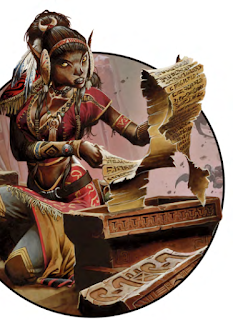The section on the races of Eberron is probably the most hefty of the new mechanical additions to 5e that Wayfinder's Guide has to offer. The first bit of the chapter gives Player's Handbook-style write-up for Eberron's unique races--changelings, kalashtar, shifters, and warforged. The second section describes how the cultural assumptions attached to the usual D&D races are altered in Eberron.
Changelings are essentially Doppelganger Juniors--they can change their appearance at will, making them the ultimate spies. Interestingly, they also take on psychological personas to match their multiple physical identities; some of these personas are passed down family lines or shared communally, so it's possible that the elf merchant you have been dealing with for a decade is actually fifty changelings playing the role.
Kalashtar...are weird. They are a compound race of humans who are bound to spirit-refugees from the plane of dreams. The relationship is more symbiosis than parasitical, but it does make the kalashtar seem alien and otherworldly--the human gets some psionic powers out of the deal.
Shifters are Lycanthrope Lite; they're (probably) the descendants of humans and were-creatures who are animalistic in appearance and can "shift" into a more bestial state to get extra hit points and some other bonus abilities.
The warforged are Magic Robots of metal and wood that were created as soldiers in the Last War. An unexpected breakthrough led to them being fully conscious and sentient. Rules-wise, eyebrows have already been raised about the armor classes they can get due to their natural protection; a 1st level warforged fighter, for example, can have an AC of 20 if they have a shield--and their AC will increase as they gain levels.
If you just want the rules for the new races, you don't need to buy Wayfinder's Guide to Eberron. They're available in this Unearthed Arcana article.
How do the "normal" races fair in Eberron? Well dwarves...seem like the dwarves in most settings. NEXT!
Elves, as always, come in a Baskin Robins array of flavors. The Aerenal elves worship their undead ancestors, so they are uncharacteristically okay with magic that is usually considered dark. The Valenar elves are warlike and seek to emulate the deeds of their illustrious ancestors. They also get access to a feat for use with a double-ended sword that seems to make two-weapon fighting obsolete, so that probably needs another look. Elves in Khorvaire are immigrants. Drow were made when giants used magic to bind shadows to elves and used to assassinate other elves.
Gnomes have a lust for knowledge, hate physical violence, and are inveterate schemers. They idea of gnomes as "smiling schemers" does the work of differentiating them from halflings and dwarves. Half-elves have their own communities because when a half-elf loves another half-elf very much they make another half-elf. Half-orcs are more likely to be seen as the offspring of backwoods types or primitives rather than the spawn of a naturally evil race, so you might need to re-think your baby orc strategy in Eberron. Halflings live in nomadic tribes and ride dinosaurs; that one kind of sells itself. Guess what? Humans are adaptable! Moving on. The chapter rounds out with brief notes on including other races that have not traditionally had a role as player characters in Eberron.
Next time: The Dragonmarked houses are the fantasy equivalent of cyberpunk megacorps.




